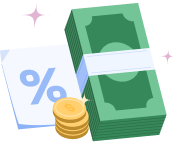According to the latest industry data, 22.5 million Americans owe a collective $222 billion in personal loans. This blog post will find the differences between secured vs unsecured personal loans and help you make an informed decision. We will also discuss the pros and cons of secured vs unsecured personal loans to help you determine which is better suited for your financial needs.
What is a Secured Loan?
A secured loan is a specific type backed by some collateral, such as a home, car, or other valuable assets. The collateral behaves as security for the lender, reducing the risk of default. Here are the key characteristics, pros, and cons of secured loans:
Characteristics of Secured Loans:
- Collateral requirement: To obtain a secured loan, you must pledge collateral to secure the loan amount.
- Higher borrowing limit: Secured loans generally offer higher borrowing limits compared to unsecured loans.
- Lower interest rates: Since the lender has the collateral as security, they can offer lower interest rates.
- Longer repayment terms: Secured loans often come with longer repayment terms, making it easier to manage monthly payments.
Pros of Secured Loans:
- Easier approval: Lenders are more likely to approve a secured loan since the collateral reduces the risk.
- Lower interest rates: Secured loans typically have lower interest rates, resulting in lower overall borrowing costs.
- Higher borrowing limits: You can borrow more significant amounts with a secured loan, making it suitable for significant expenses like home renovations or buying a car.
Cons of Secured Loans:
- Risk of asset seizure: If you default on the loan, the lender has the right to seize the collateral to recover their losses.
- Longer repayment terms: While longer repayment terms can be advantageous, they also mean you’ll be paying interest for an extended period, increasing the overall cost of the loan.
- Limited to asset value: The loan amount you can borrow is restricted to the value of the collateral you provide.
What is an Unsecured Loan?
Opposite to secured loans, unsecured loans require no collateral for security. These loans are based on the borrower’s creditworthiness and repayment ability. As of Q4 2022, more than 22.5 million individuals hold unsecured personal loans, with an average debt per borrower at $11,116.
Characteristics of Unsecured Loans:
- No collateral requirement: Unsecured loans do not require you to pledge any assets as collateral.
- Based on creditworthiness: Lenders evaluate your credit score and financial history to determine your eligibility and interest rate.
- Smaller borrowing limits: Unsecured loans generally offer smaller borrowing limits compared to secured loans.
- Higher interest rates: Since there is no collateral to reduce the lender’s risk, unsecured loans typically come with higher interest rates.
Pros of Unsecured Loans:
- No risk of asset seizure: As no collateral is involved, you do not risk losing assets if you default on the loan.
- Quicker processing: Unsecured loans usually have a faster approval and disbursement process since no collateral valuation is required.
- Versatile use: You can use unsecured loans for various purposes, such as consolidating debt, funding a vacation, or covering medical expenses.
Cons of Unsecured Loans:
- Higher interest rates: Unsecured loans often come with higher interest rates, resulting in higher borrowing costs over time.
- Stricter eligibility criteria: Lenders may have more stringent requirements for credit scores and income verification to mitigate the risk of default.
- Smaller borrowing limits: Unsecured loans typically offer smaller loan amounts, which may need to be increased for significant expenses.
Secured vs. Unsecured Personal Loans: What’s the Difference?
Now that we have explored the pros, cons, and characteristics of secured and unsecured loans both, let’s compare them directly to understand the differences:
- Collateral: The most significant difference between secured and unsecured loans is the presence of collateral. Fast loans require collateral, whereas unsecured loans do not.
- Risk: Secured loans are comparatively less risky for lenders since they have collateral to recover their losses in case of default. Since no collateral is involved, unsecured loans carry a higher risk percentage for lenders.
- Interest Rates: Secured loans have comparatively lower interest rates most of the time due to the reduced risk for lenders. On the other hand, unsecured loans mostly have interest rates on the higher side to compensate for the higher risk.
- Borrowing Limits: Secured loans offer higher borrowing limits, often determined by the value of the collateral. Unsecured loans have smaller borrowing limits, typically based on your creditworthiness and income.
- Eligibility Requirements: Secured loans are relatively easier to qualify for since collateral reduces the risk for lenders. Unsecured loans may have stricter eligibility criteria, emphasizing credit scores, income, and financial stability.
Secured vs Unsecured Personal Loans: Which is Better for Me?
Choosing between a secured and unsecured loan depends on your unique financial situation and borrowing needs. Consider the following factors when making a decision:
- Creditworthiness: If you have a strong credit history and a high credit score, you may qualify for competitive interest rates on unsecured loans. However, a secured loan might be a better option if your credit could be better.
- Borrowing Amount: A secured loan may be more suitable due to higher borrowing limits if you require a substantial loan amount. For more minor expenses, an unsecured loan might suffice.
- Risk Tolerance: If you are uncomfortable risking your assets, an unsecured loan provides the advantage of not requiring collateral. However, be prepared for higher interest rates.
- Repayment Term: Consider the repayment term that works best for you. Secured loans often offer more extended periods, resulting in lower monthly payments. Unsecured loans usually have shorter repayment terms.
Conclusion
Secured loans offer lower interest rates and higher borrowing limits but carry the risk of asset seizure. Unsecured loans are not required collateral but typically have higher interest rates and smaller borrowing limits. Assess your financial circumstances, creditworthiness, and borrowing needs to make an informed decision while choosing between secured vs unsecured personal loans.
Beem can help you find, compare options and choose the best personal loan for you to meet your needs.
FAQs
1. Are Secured Loans Only for Homeowners?
Secured loans can be obtained by pledging various assets, including homes, cars, or valuable possessions. Homeownership is not a requirement, but you need to provide eligible collateral.
2. Can Unsecured Loans Help Improve My Credit Score?
Making timely repayments on an unsecured loan can positively impact your credit score. Demonstrating responsible borrowing behavior can improve your creditworthiness over time.
3. How Long Does the Approval Process Take for Secured and Unsecured Loans?
The loan approval process varies depending on the lender, but secured loans may take longer due to collateral evaluation. Unsecured loans typically have a quicker approval process since no collateral is involved.
Remember to consult with financial professionals or loan experts before making any borrowing decisions to ensure the loan terms align with your financial goals and capabilities.
Try Beem’s personal loan feature to get all the information you need on personalized rates and explore loan options ranging from $500 to $100,000, without impacting your credit score!
















































